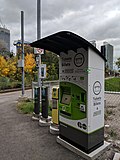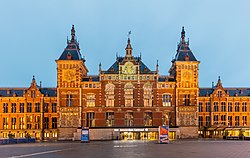Train station

A train station or railway station (also called a railroad station, rail station, or depot) is a place where passengers of rail transport can get on and off trains and/or goods may be loaded or unloaded.
Early stations were usually built to handle passengers and goods. Today, goods are usually only unloaded at big stations. Stations are next to a railway line, or they are the terminus for a route. Usually there are platforms to let passengers get on and off the train easily and safely. Many stations have things such as shelters, ticket sales and benches.
The busiest railway station in the world is Shinjuku Station in Tokyo, Japan. The largest station is Nagoya Station in Nagoya, Japan. The busiest station in Europe is Clapham Junction in south London in the United Kingdom. At peak times, there is one train every 13 seconds there.[1]
Terminus
A "terminus" or "terminal" is a station at the end of a railway line. Trains arriving there have to end their journeys (terminate) or reverse out of the station. The public entrance to the station and the main reception are at the far end of the platforms.
Different types of railway stations
Luxulyan railway station in Cornwall, a basic station. Trains stop only on request. People who want to get off here must tell the conductor. The station was used by 2,522 people in 2022-23.
Terminal station (seen here is the Gare de Lyon, one of six in Paris). Trains that go through (and do not terminate) here must change direction. Passengers can walk from one track to another without the need to cross tracks.
Platforms at Leeds Station, Leeds, England.
Interchange station in Birmingham, England. Passengers can change from one train route to another, often without having to leave the station or even the platform, or pay an additional ticket.
Station facilities
Railway stations usually have either ticket booths, or ticket machines. Ticket sales can also be together with an information desk or a shop. Many stations have a shop or a kiosk.
Bigger stations often have fast-food or restaurants. In some countries these stations also have a bar, or a pub. Other station facilities are: toilets, luggage rooms, lost-and-found (lost property office), timetables, trolleys, waiting rooms, taxi ranks and bus stops.
Train Station Media
Milan Centrale, Italy, is the largest railway station in Europe by volume. It is a notable Art Deco building.
Station with train and coal depot by Gustave Le Gray (about 1850–1860s)
A Presto contactless smart card reader and self-serve ticket machine at a suburban train station in Toronto, Canada
Ticket counters at the Nyugati Railway Station in Budapest, Hungary
The Wishing Well halt at St Keyne, Cornwall, one of only two stopping places bearing the name "halt" in the UK
The Amsterdam Centraal station in the Netherlands
A halt at Koygorou on the Niamey-Dosso railway in Niger
Yellow tactile paving on the train platform at Union Station in Toronto
References
| Wikimedia Commons has media related to Lua error in Module:Commons_link at line 62: attempt to index field 'wikibase' (a nil value).. |
- ↑ Kirshner, Hannah (2024-05-17). "Now One Fast Train From Tokyo: Culture, Crafts and Hot Springs" (in en-US). The New York Times. . https://www.nytimes.com/2024/05/17/travel/japan-onsen-kaga-hot-springs.html. Retrieved 2024-05-20.




















